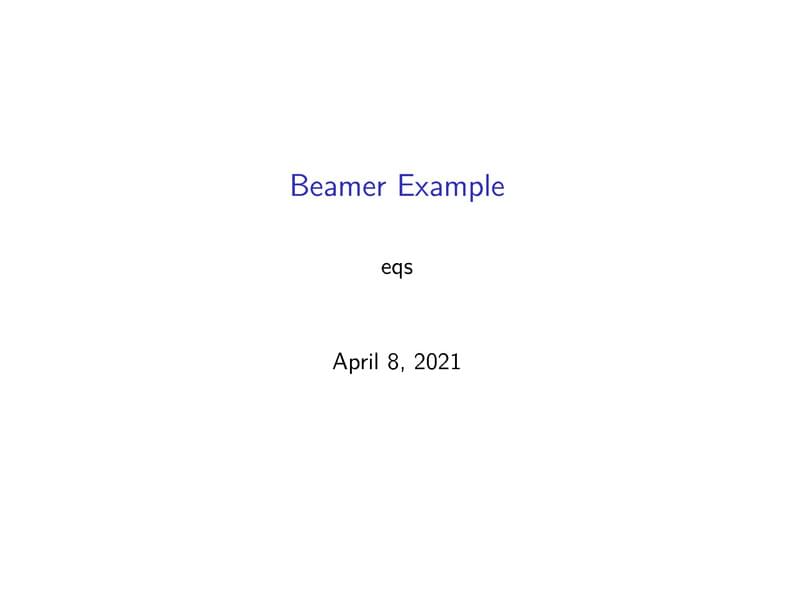
beamer-math-template
Author:
eqs
Last Updated:
5 years ago
License:
Creative Commons CC BY 4.0
Abstract:
https://github.com/eqs/beamer-math-template

\begin
Discover why over 20 million people worldwide trust Overleaf with their work.

\begin
Discover why over 20 million people worldwide trust Overleaf with their work.
\documentclass{beamer}
\usepackage{amsmath, amssymb}
%\usepackage[utf8]{inputenc}
\usepackage{zxjatype}
\usepackage[ipa]{zxjafont}
\usepackage{mymacro}
\usefonttheme{professionalfonts}
\setbeamertemplate{navigation symbols}{}
% --- page number ---
\setbeamertemplate{footline}{%
\raisebox{10pt}{\makebox[\paperwidth]{\hfill\makebox[7em]{\normalsize\texttt{\insertframenumber/\inserttotalframenumber}}}}%
}
% Presenter's note
% \setbeameroption{show notes on second screen}
\title{Beamer Example}
\author{eqs}
\date{\today}
\begin{document}
\begin{frame}[plain]
\maketitle
\end{frame}
\begin{frame}{About this Beamer project}
\begin{itemize}
\item This template is available for both Japanese and English.
\item 日本語と英語のどっちのプレゼンでも使えます.
\end{itemize}
\note{
Please write presenter's note here.
発表者ノートはここに書く.
}
\end{frame}
\begin{frame}[fragile]{Commands for brackets in equations}
\begin{itemize}
\item \verb|\nbracket|: \verb|\left( ... \right)|
\begin{align*}
\lim_{x \to \infty} \nbracket{1 + \frac{1}{x}}^x = e
\end{align*}
\item \verb|\cbracket|: \verb|\left\{ ... \right\}|
\begin{align*}
\frac{\beta}{2}\sum_{n=1}^N \cbracket{t_n - \mathbf w^\top\boldsymbol\phi(\mathbf x_n)}^2
\end{align*}
\item \verb|\rbracket|: \verb|\left[ ... \right]|
\item \verb|\abracket|: \verb|\left\langle ... \right\rangle|
\end{itemize}
\end{frame}
\begin{frame}[fragile]{Highlight Commands}
\begin{itemize}
\item \verb|\highlight|
\item \verb|\highlightcap|
\item \verb|\highlightcaphead|
\item \verb|\highlightcapoverlay|
\item \verb|\highlightcapheadoverlay|
\end{itemize}
\end{frame}
\begin{frame}[plain,c]
\begin{center}
\Large Example Slides
\end{center}
\end{frame}
\begin{frame}{Example 1 (\texttt{highlight})}
\begin{align*}
&x^2 - 6x + 2 \\
&= \highlight[red]{x^2 - 6x + 9} - 7 \\
&= \highlight[red]{(x - 3)^2} - 7
\end{align*}
\end{frame}
\begin{frame}{Example 2 (\texttt{highlightcap}, \texttt{cbracket})}
When we consider a Gaussian prior $p(\mathbf w | \alpha) = \mathcal N(\mathbf w | \boldsymbol 0, \alpha^{-1}\mathbf I)$,
maximization of the corresponding posterior $p(\mathbf w | \boldsf{t})$ with respect to $\mathbf w$ is equivalent to the minimization of
\begin{align*}
\highlightcap<2->[red]{\displaystyle\frac{\beta}{2}\sum_{n=1}^N \cbracket{t_n - \mathbf w^\top\boldsymbol\phi(\mathbf x_n)}^2}{an error function}
+ \highlightcap<3->[blue]{\displaystyle\frac{\alpha}{2}\mathbf w^\top\mathbf w}{a quadratic regularization} \tag{3.55'}
\end{align*}
the minimization corresponds to (3.27) with $\lambda = \alpha/\beta$.
\end{frame}
\begin{frame}{Example 3 (\texttt{highlightcapoverlay})}
For the moment, the noise precision $\beta$ as a known constant.
Where the likelihood function of $t$ is defined as:
%%begin novalidate
\begin{align*}
p(\boldsf t | \mathbf w)
= \prod_{n=1}^N
\highlightcapoverlay<2->{\mathcal N(t_n | \mathbf w^\top \boldsymbol\phi(\mathbf x_n), \beta^{-1})}{The exponential of a quadratic func.\ of $\mathbf w$} \tag{3.10'}
\end{align*}
%%end novalidate
\end{frame}
\begin{frame}{Example 4 (multi-columns)}
\begin{columns}[c]
\begin{column}{0.6\hsize}\centering
\begin{tikzpicture}[thick,scale=0.8, every node/.style={scale=0.8}]
\node[draw, circle, minimum width=1cm] (a) at (-2, 1) {$a$};
\node[draw, circle, minimum width=1cm] (c) at (0, 0) {$c$};
\node[draw, circle, minimum width=1cm] (b) at (2, 1) {$b$};
\alt<2->{
\node[draw, circle, minimum width=1cm, fill=blue!20!white]
(d) at (0, -2) {$d$};
}{
\node[draw, circle, minimum width=1cm] (d) at (0, -2) {$d$};
}
\draw[-latex] (a) -- (c);
\draw[-latex] (b) -- (c);
\draw[-latex] (c) -- (d);
\end{tikzpicture}
\end{column}
\begin{column}{0.4\hsize}
\begin{itemize}
\item Item 1
\item Item 2
\item Item 3
\end{itemize}
\end{column}
\end{columns}
\end{frame}
\end{document}